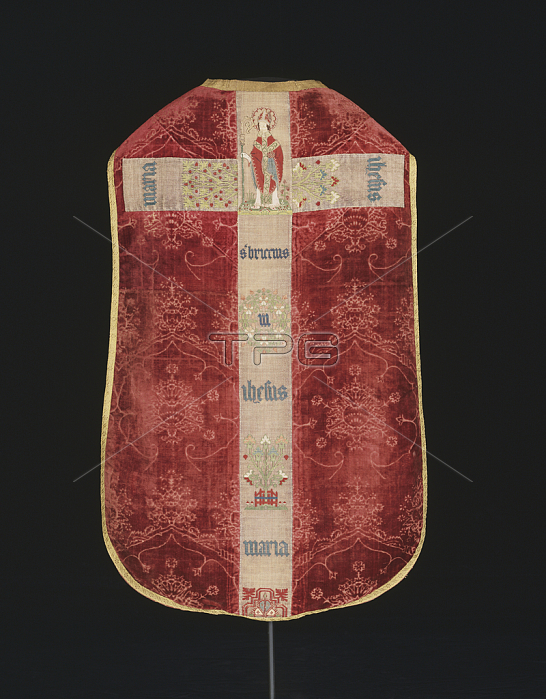
434333 Chasuble, c.1450-80 (Cut & voided silk velvet weave; orphreys: linen compound twill weave with silk embroidery in couching, chain, encroaching satin, & padded satin stitches, laid work, & French knots) by Italian School, (15th century); center back length:113 cm; Philadelphia Museum of Art, Pennsylvania, PA, USA; (add.info.: Orphrey made in Cologne, Germany. During the late Middle Ages, decorative woven borders were used as an alternative to embroidered orphrey bands and crosses on church vestments (ceremonial garments worn by church officials). The dimensions, shape, and placement of the orphreys of this chasuble from the late fifteenth-early sixteenth century indicate that it was used in Northern Europe, probably France. Constructed from Italian cut and voided silk velvet decorated with the thin-line pomegranate pattern that was popular in the second half of the fifteenth century, it is ornamented both front and back with orphreys of a type woven in Cologne, Germany, from the fourteenth to the early sixteenth century. These narrow woven borders were manufactured on a large scale in Cologne and exported throughout Europe. The Cologne orphreys had designs of flowering trees, wreaths, geometric patterns, and inscriptions. Additional embellishment frequently took the form of embroidered figures, such as the one seen here of Saint Brice, archbishop of Tours.These bands are woven with colored silks on a background of gold thread with religious inscriptions in Latin--"Jesus Mary Hail Queen [of] Sorrows" (front) and "Mary Jesus Saint Briccius" (back)--as well as the figure of Saint Brice, archbishop of Tours, which is overembroidered in satin stitch. ); 穢 Philadelphia Museum of Art ; Purchased with the Elizabeth Wandell Smith Fund, 1939; Italian, out of copyright.
| px | px | dpi | = | cm | x | cm | = | MB |
Details
Creative#:
TOP27061925
Source:
達志影像
Authorization Type:
RM
Release Information:
須由TPG 完整授權
Model Release:
No
Property Release:
No
Right to Privacy:
No
Same folder images:

 Loading
Loading